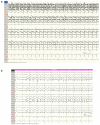The frequency and timing of epileptiform activity on continuous electroencephalogram in comatose post-cardiac arrest syndrome patients treated with therapeutic hypothermia
- PMID: 22366352
- PMCID: PMC8851397
- DOI: 10.1016/j.resuscitation.2012.02.015
The frequency and timing of epileptiform activity on continuous electroencephalogram in comatose post-cardiac arrest syndrome patients treated with therapeutic hypothermia
Abstract
Aim: The incidence and timing of electrographic seizures and epileptiform activity in comatose, adult, post-cardiac arrest syndrome (PCAS) patients treated with therapeutic hypothermia (TH) have not been extensively investigated. We hypothesized that onset most frequently occurs within the first 24 h post-arrest and is associated with poor neurologic outcome.
Methods: Single-center, retrospective analysis of a cohort of 38 comatose PCAS patients treated with TH and continuous-EEG-monitoring (cEEG), initiated as soon as possible after ICU admission. All raw cEEG waveform records were cleared of annotations and clinical information and classified by two fellowship-trained electroencephalographers.
Results: Twenty-three percent (9/38) of patients had electrographic seizures (median onset 19 h post-arrest); 5/9 (56%) had seizure-onset prior to rewarming; 7/9 (78%) had status epilepticus. Forty-five percent (17/38) had evidence of epileptiform activity (electrographic seizures or interictal epileptiform discharges), typically occurring during first 24 h post-arrest. Interictal epileptiform activity was highly associated with later detection of electrographic seizures (6/14, 43%, p=0.001). Ninety-four percent (16/17) of patients with epileptiform activity had poor neurologic outcome or death at discharge (Cerebral Performance Category scale 3-5; p=0.002) as did all (9/9) patients with electrographic seizures (p=0.034).
Conclusions: Electrographic seizures and epileptiform activity are common cEEG findings in comatose, PCAS patients treated with TH. In this preliminary study, most seizures were status epilepticus, had onset prior to rewarming, evolved from prior interictal epileptiform activity, and were associated with short-term mortality and poor neurologic outcome. Larger, prospective studies are needed to further characterize seizure activity in comatose post-arrest patients.
Copyright © 2012 Elsevier Ireland Ltd. All rights reserved.
Figures

Comment in
-
Seizures and status epilepticus in post cardiac arrest syndrome: therapeutic opportunities to improve outcome or basis to withhold life sustaining therapies?Resuscitation. 2012 Jul;83(7):791-2. doi: 10.1016/j.resuscitation.2012.04.003. Epub 2012 Apr 15. Resuscitation. 2012. PMID: 22513351 No abstract available.
References
-
- Sagalyn E, Band RA, Gaieski DF, Abella BS. Therapeutic hypothermia after cardiac arrest in clinical practice: review and compilation of recent experiences. Crit Care Med. 2009;37:S223–6. - PubMed
-
- Nolan JP, Morley PT, Vanden Hoek TL, Hickey RW, Kloeck WG, Billi J, et al. Therapeutic hypothermia after cardiac arrest: an advisory statement by the advanced life support task force of the International Liaison Committee on Resuscitation. Circulation. 2003;108:118–21. - PubMed
-
- Khot S, Tirschwell DL. Long-term neurological complications after hypoxicischemic encephalopathy. Semin Neurol. 2006;26:422–31. - PubMed
-
- Nielsen N, Hovdenes J, Nilsson F, Rubertsson S, Stammet P, Sunde K, et al. Outcome, timing and adverse events in therapeutic hypothermia after out-of-hospital cardiac arrest. Acta Anaesthesiol Scand. 2009;53:926–34. - PubMed
-
- Krumholz A, Stern BJ, Weiss HD. Outcome from coma after cardiopulmonary resuscitation: relation to seizures and myoclonus. Neurology. 1988;38:401–5. - PubMed
Publication types
MeSH terms
Grants and funding
LinkOut - more resources
Full Text Sources
Medical

